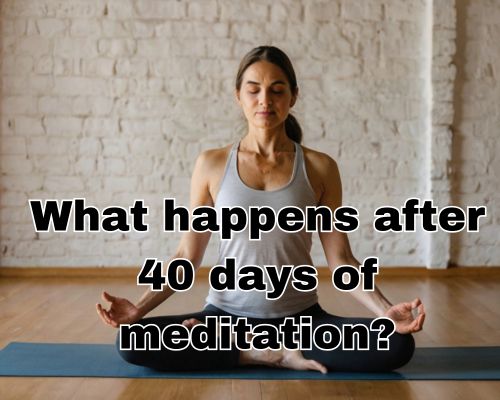
What Happens After 40 Days of Meditation? A Journey of Transformation in Mornington, Australia
In the lush, coastal serenity of Mornington, Australia, where the breeze from Port Phillip Bay whispers through eucalyptus groves, a subtle revolution is happening—one breath at a time. Meditation, especially when practiced consistently for 40 days, is proving to be more than just a relaxation technique. It’s a neurobiological, psychological, and spiritual upgrade. So, what happens after 40 days of meditation? The transformation is as measurable as it is mystical.

With Bikram Yoga Mornington, we’ll explore the powerful impact of 40 consecutive days of meditation, integrating salient concepts like neuroplasticity, mindfulness, and subconscious reprogramming while rooting the conversation in the local wellness culture of Mornington, a hub of holistic living in Victoria, Australia.
Why 40 Days? The Significance in Spiritual and Scientific Traditions
The number 40 is no random benchmark. In yogic philosophy, particularly Kundalini Yoga, it’s believed that practicing a kriya or meditation for 40 days can break negative habits and rewire the subconscious mind. This aligns closely with research in habit formation psychology, which suggests that consistent, daily action over 30 to 66 days helps solidify new patterns.
In Mornington’s vibrant wellness community—from beachside yoga sessions at Mills Beach to mindfulness retreats nestled near Arthurs Seat—the 40-day framework is gaining traction. Local instructors often guide students through 40-day meditation challenges, reflecting both ancient Eastern traditions and modern Western neuroscience.
Week-by-Week Breakdown: The Mind and Body Shift
🌱 Week 1: Resistance and Revelation
The initial days often feel turbulent. As the mind detoxes, restlessness, emotional turbulence, and even boredom emerge. This is natural. Meditation starts shining a light on mental clutter.
Local practitioners at Mornington Peninsula Yoga note that students report increased awareness of their thought patterns during this stage—especially reactions to stress, social triggers, and digital distractions.
🌿 Week 2: Emotional Release and Regulation
As the practice deepens, so does self-awareness. Emotional responses begin to mellow. The amygdala, the brain’s fear center, starts to quiet down, while the prefrontal cortex—responsible for rational decision-making—strengthens.
This emotional stabilization is often reflected in improved relationships and calmer reactions. Mornington wellness coaches frequently observe their clients experiencing enhanced emotional intelligence and reduced anxiety symptoms by the second week.
🍃 Week 3: Physiological Alignment
At around day 21, real physiological benefits appear. Consistent meditation has been shown to lower cortisol levels, reduce blood pressure, and improve heart rate variability. For Mornington residents who combine meditation with outdoor activities like hiking in the Briar’s Sanctuary, these effects are amplified by exposure to nature.
Notably, practitioners often report better sleep quality, improved digestion, and even changes in appetite as the parasympathetic nervous system takes precedence over the fight-or-flight response.
🌸 Week 4: The Subconscious Shift
By days 30 to 40, a profound shift begins: the reprogramming of the subconscious mind. Deep-seated beliefs, emotional blocks, and limiting narratives begin to dissolve. This is where transformation blooms.
Meditators report enhanced intuition, mental clarity, and a noticeable reduction in reactivity. They often describe a feeling of “coming home” to themselves. In local circles, such as Meditation Mornington Meetup Groups, many describe the experience as “unshakable inner calm.”
Scientific Backing: What the Research Says
Peer-reviewed studies lend credence to these experiential reports:
- A Harvard study found that just 8 weeks of mindfulness meditation leads to measurable growth in the hippocampus (linked to learning and memory) and reduction in the amygdala.
- The University of Wisconsin-Madison reported that long-term meditators have elevated gamma brainwave activity, linked to heightened states of awareness and compassion.
These findings are not abstract concepts but lived realities for many in Mornington’s growing meditation community, especially those participating in programs offered at places like Wellness Manor or Belura Health Retreat.
Meditation as Mental Fitness: Creating Long-Term Resilience
After 40 days of meditation, practitioners often describe life with a new lens. Reactions slow. Space opens between stimulus and response. There’s a softening of self-judgment and a sense of resilience.
This is especially relevant in today’s high-stress lifestyle, even in relaxed towns like Mornington. The hustle of small business, remote work, and parenting is real. But daily meditation—whether in a studio like Bikram Yoga Mornington, on the Mornington Pier, or in your own backyard—becomes a shield and a sanctuary.
How to Begin Your Own 40-Day Meditation Journey in Mornington
If you’re inspired to explore what happens after 40 days of meditation, here’s a simple roadmap to start in Mornington, Victoria:
1. Choose Your Technique
- Mindfulness meditation: Great for beginners.
- Kundalini kriyas: Ideal for those seeking energetic transformation.
- Loving-kindness meditation: Helpful for healing emotional wounds.
2. Pick a Space and Time
Establish consistency. Whether it’s at The Private Sea Wellness Centre or your own garden, the key is repetition.
3. Track Your Progress
Use journals or apps like Insight Timer or Headspace to log your practice and reflections.
4. Engage with Community
Join local groups or attend full moon meditations by the beach. Community strengthens commitment.
5. Embrace the Process
Remember, the journey isn’t linear. Discomfort is part of the detox. Trust the process.
Beyond 40 Days: Integration and Expansion
What happens after 40 days of meditation doesn’t end at day 41—it opens a gateway. Most practitioners don’t stop. Instead, they evolve their practice. Some add breathwork, others deepen into silence retreats or yoga nidra.
In Mornington, there’s a rising trend toward meditative living: weaving mindfulness into surfing, gardening, cooking, and parenting. The benefits continue to grow as the nervous system resets and the inner compass strengthens.
Final Thoughts: Is It Worth It?
Absolutely. Meditation is no longer just a spiritual practice—it’s a foundational wellness tool. For those in Mornington, where natural beauty meets a thriving conscious community, the 40-day meditation journey is a chance to recalibrate, realign, and rediscover a grounded sense of peace.
So if you’re wondering what happens after 40 days of meditation, the answer is simple yet profound: you begin to meet yourself, fully present, and finally free.


